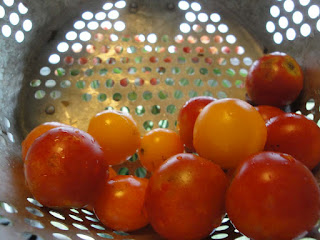A SEE-YOU-LATER LETTER....
THE VEGETALBES YOU ATE THIS
SEASON were grown with seed from companies that scorn genetically modified seed
and care about the state of organic seed.
THE VEGETABLES YOU ATE THIS
SEASON were grown on land amended only with composted horse manure from a half
mile away and from green manure crops we planted to feed the soil with nitrogen
and soil structure. When bugs became a problem on certain crops this year,
instead of drowning the crop in pesticides, we lost it and focused on
another. We controlled weeds and
bugs by keeping the plants well nourished and using tools like human hands, a
cultivating tractor, trap plants, the occasional use of an organic spray called
diatamaceous earth, and prayer (crossed fingers). Because we are a diversified farm with a customer base like
you, we can run with the punches when the season throws us a drought or a flood
or whatever. You didn’t get much
in the way of leafy greens during July and August and we didn’t get the best
yield on butternuts because of the dryness and heat, but we made up for it with
other crops like potatoes, carrots, beets and fall greens. Pretty good season all told.
THE VEGETABLES YOU ATE THIS
SEASON were grown by Todd and a sprightly troupe of leprechauns named Meredith,
Justin, Laura, Maeve, Dave, Carolyn, and our labor manager Joe Pisciotto. Thanks to 15 worker shareholders on the
farm and 7 worker shareholders off farm. Interns are people curious about this
new model of farming, how to get into it, how to change the world, etc.
WANT TO BE SURE OF ALL
THIS? Next season, come
visit.!! We are a very small farm
in our 5th year (3rd at this size). We have lots to learn
and lots of infrastructure still to build. Come visit and see how we make it work. View our compost pile. Witness our practices. Pull a weed.
There’s this myth floating
around that “organic can’t feed the world.” That is a bunch of malarkey.* Plenty of studies show otherwise, including one that was
released last year by the UN Environment Programme. UNEP reported that organic practices in Africa outperformed
industrial, chemical-intensive conventional farming, and also provided
environmental benefits such as improved soil fertility, better retention of
water and resistance to drought. The Rodale Institute recently completed their
report on the longest side-by-side conventional vs. organic farming systems
trial ever completed in the U. S.
In this 30-year study, they found organic yields match conventional
yields in long-term trials with much less environmental impact.
Most farmland in our
country does not “feed the world.” It supplies raw material for cereal, junk
food and feed for cows. By the
way.
*read MOSES publication Organic
Broadcaster, v. 20, No. 2 or visit
www.rodaleinstitute.org/fst30years
Don’t get freaked out. Feel very very
good. Thanks for making a
difference.
And eat your vitamins.
Your farmers,
Julia and Todd McDonald




















































